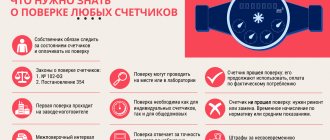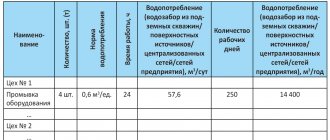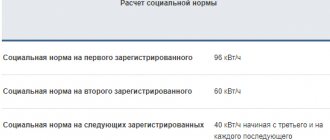Housing and communal services
59
Citizens are required by law to install individual water meters in their apartments and houses, where this is possible. If it is technically possible to install meters, but citizens refuse, then when calculating fees for using the resource, consumption standards with increasing coefficients are applied. As a result, it is much more profitable to pay only for the amount that was actually consumed, without overpaying for extra cubic meters of water. And this can only be done if you have an individual meter. From the article you will learn what the standard consumption of cold and hot water is for 1 person per month without a meter in 2021 by region of the Russian Federation.
The legislative framework
The provision of public services, which also includes cold and hot water supply, is regulated by the Rules approved by Government Decree No. 354. They contain formulas that are used to calculate fees for water use in apartments where meters are installed and without them.
Standards for water consumption and disposal have remained unchanged for almost 30 years. These may vary slightly depending on the type of home.
The cost of one cubic meter of water is set by the regional authorities in compliance with the norms of Federal Law No. 210-FZ, which regulates the application of tariffs in this area.
According to the Housing Code of the Russian Federation, the amount of payment for utilities (CS) is calculated based on the volume of consumed utilities (CS), determined by the readings of metering devices, and in their absence, based on the standards for consumption of utilities (CS).
Standard
- this is an approved quantitative indicator of the volume of consumption of a utility resource per 1 person per month or per 1 square meter of living space in the absence of a meter. Depends on the type of service.
For example, the standard for cold water consumption in the region, depending on the characteristics of the house, is from 1.2 to 7.6 cubic meters per person, and the standard for thermal energy consumption is calculated based on square meters and for residents of Stavropol it ranges from 0.00136 to 0.0221 gigacalories per square meter. In other territories the figure may differ.
Standards are set for resources:
· in residential or non-residential premises;
· for the purpose of maintaining common property in an apartment building (MCD);
· when using land and outbuildings.
Individual metering devices
To determine the actual volume of resource consumed, all consumers of water and electricity services are required to install water and electricity meters (if technically possible). This is provided for by Federal Law No. 261-FZ of November 23, 2009 “On energy saving and increasing energy efficiency.”
If there is no individual device (IPU), the consumption standard of the CU is used to calculate the payment for utility resources.
If it is not technically possible to install an IPU, the owners need to contact the contractor (management company, HOA or resource supply organization) and receive an inspection report confirming the lack of technical ability to install such a device.
Owners of apartment buildings recognized as dilapidated, unsafe or subject to demolition are also exempt from installing IPU.
The criteria for the presence/absence of technical capability, the form of the inspection report and the procedure for filling it out are described in the order of the Ministry of Regional Development of the Russian Federation dated December 29, 2011 No. 627.
Individual thermal energy devices are mandatory for apartment houses put into operation since January 2012, all new buildings, apartment houses after reconstruction and major repairs (again, if technically possible). Those whose premises are heated using gas equipment must install gas meters in their apartments.
Paying for water and electricity according to standards, as a rule, is not profitable, since this is the volume of a utility resource, which is calculated using special formulas and which theoretically can be consumed by one person per month. In addition, if the owners of premises in an apartment building are obliged to equip their premises with metering devices for used water and electrical energy, but have not fulfilled this obligation, when calculating the payment for utilities in relation to the owner, an increasing factor of 1.5 is applied to the consumption standard for the corresponding type of utilities, which he must pay. In this case, it does not matter whether the owner uses the premises belonging to him for living or rents it out to other persons.
In this case, the use of an increasing coefficient is aimed at stimulating consumers to equip residential premises with private monitoring systems and is not a penalty. Moreover, if the owner proves that installing meters in the apartment is technically impossible, increasing coefficients will not be applied.
Installing an IPU allows you to significantly reduce the cost of consumed resources, since the amount of payment for them will be calculated based on the actual readings of such devices. And they, as a rule, differ significantly from the standards in a smaller direction.
Example
. 4 people live in a 3-room apartment. Cold and hot water supply is centralized. Gas is used only for cooking. Water and electricity meters are installed. Let's compare how much residents will pay in an apartment with similar characteristics, but without meters:
Regulatory legal framework
The standards are calculated in accordance with the Rules for establishing and determining standards for the consumption of utility services and utility resources for the maintenance of the common property of an apartment building (Resolution of the Government of the Russian Federation of May 23, 2006 No. 306 (hereinafter referred to as Rules No. 306)), the Rules for the provision of utility services to owners and users of premises in apartment buildings and residential buildings (Resolution of the Government of the Russian Federation dated May 6, 2011 No. 354 (Rules No. 354) and regulations adopted at the regional level.
In the Stavropol Territory, standards for utility resources and services are approved by the Ministry of Housing and Communal Services of the Stavropol Territory (hereinafter referred to as the Ministry of Housing and Communal Services of the SK). The corresponding orders are posted on the official website of the Ministry of Housing and Communal Services of the SK www.mingkhsk.ru in the “Activities” section.
The validity period of the approved standards is at least three years. During this period, they are not subject to revision, except in cases provided for by Rules No. 306. For example, if the degree of energy efficiency of the house has changed, major repairs have been carried out or climatic conditions have changed and the volume of consumption of utility resources has changed by more than 5 percent, etc.
Standards are determined based on the month of consumption of the corresponding utility resource.
Utility consumption standards
The Ministry of Housing and Communal Services of the UK has established consumption standards for cold and hot water supply, sewerage, electricity and gas supply. And also for thermal energy for heating cold water to provide hot water supply services. The corresponding orders are posted on the website of the Ministry of Housing and Communal Services of the UK in the above section.
1. Gas supply (order of the Ministry of Housing and Communal Services of the UK dated March 11, 2021 No. 87);
2. Cold/hot water supply, sanitation (order of the Ministry of Housing and Communal Services of the UK dated May 16, 2013 No. 131 o/d);
3. Electricity supply (order of the Ministry of Housing and Communal Services of the UK dated August 29, 2012 No. 298-od);
4. Thermal energy for heating cold water to provide hot water supply services (order of the Ministry of Housing and Communal Services of the UK dated October 2016 No. 399).
When determining standards for different CUs, different characteristics of the house were taken into account:
· for hot and cold water supply - number of storeys of the building, type of heat supply system, type of hot water supply system, wear and tear of in-house engineering systems, etc.;
· for power supply – the number of rooms in the apartment, the area of the house, wear and tear of in-house engineering systems;
· for gas supply (when gas is consumed for heating needs) - material of walls, roofs, volume of residential premises, area of enclosing structures and windows, wear and tear of in-house engineering systems;
· for gas supply (when gas is consumed for cooking and (or) heating water) - wear and tear of the in-house utility gas supply system;
In what cases is the amount of payment for CG
In addition to the lack of meters, there are a number of situations when it is possible to calculate the payment for utilities according to the standard.
1. The procedure for connecting the consumer’s in-house equipment to the in-house engineering systems is violated, and it is impossible to determine the power of unauthorized connected equipment. The Contractor will calculate the fee for CG based on the volume determined on the basis of the standard, applying an increasing factor of 10 to such volume.
2. Unauthorized interference in the operation of the meter located at the consumer was detected, which caused distortion of the device readings. In this situation, the device readings are not used to calculate the payment for the utility bill. The Contractor makes a recalculation based on the volume calculated on the basis of the standard using an increasing factor of 10 (clause 81(11) of the Rules), but no more than three months preceding the month in which unauthorized interference in the operation of the meter was detected and before the date eliminating such interference.
3. The consumer repeatedly (two or more times) did not allow the contractor or his authorized person into his residential premises to check the condition of installed and put into operation individual, common (apartment) metering devices, and to check the accuracy of the information provided about the readings of such metering devices. Provided that the executor draws up an act of refusal to allow access to the metering device, the fee for the CG is calculated based on the CG consumption standards using increasing factors (clause 85 (3) of the Rules).
The payment for utility services is recalculated after the consumer submits a written application for the use of individual metering devices or distributors to calculate the amount of payment for services and readings are taken from the devices or distributors (clause 60 (1) of the Rules).
Standards for consumption of utility resources
for the maintenance of common property in the apartment building
Standard for consumption of communal resources for the maintenance of common property (KR on SOI),
is used to calculate the amount of payment for cold, hot water, wastewater disposal and electricity consumed when performing the minimum list of works and services necessary to ensure the proper maintenance of common property in the apartment building, approved by Decree of the Government of the Russian Federation dated April 3, 2013 No. 290.
These resources are necessary for the normal functioning of the apartment building, the convenience and safety of its residents. The operation of the elevator, pumping equipment, intercom, lighting of the entrance, basement, technical rooms and local area, wet cleaning and flushing of water and heat supply systems, etc. depend on this.
In the receipt for payment of housing and communal services, these expenses are reflected in the top line, as part of the fee for the maintenance of common property.
The owner of premises in an apartment building is obliged to bear the costs of maintaining the premises he owns, as well as to participate in the costs of maintaining common property in proportion to his share in the right of common ownership.
The obligation to pay the CD for SOI is also assigned to the owners and users of non-residential premises - legal entities and individual entrepreneurs operating in non-residential premises of apartment buildings, as well as in residential premises used for non-residential purposes.
Rules for calculating the amount of payment for the consumption of such resources have been adopted in order to correctly take into account the utility resources in each home and distribute costs in accordance with actual consumption.
You can familiarize yourself with the standards for the Kyrgyz Republic on SOI on the ministry’s website in the above section.
1. Cold and hot water, wastewater disposal for the purpose of maintaining the common property of the apartment building (order of the Ministry of Housing and Communal Services of the UK dated May 29, 2017 No. 162);
2. Electricity used for the maintenance of the common property of the apartment building (order of the Ministry of Housing and Communal Services of the UK dated May 29, 2021 No. 161);
These standards do not apply to apartment buildings with a direct control method or houses in which the control method is not selected or the selected control method is not implemented. For these houses, the payment for the Kyrgyz Republic on SOI remained as part of the utilities and the procedure for their calculation did not change.
When determining standards for consumption of the Kyrgyz Republic on SOI, the following are taken into account:
for cold and hot water
— number of floors, type of heat supply system (open, closed), type of hot water supply system, equipment in common areas with water taps and sanitary equipment;
for electricity
— number and types of equipment and devices consuming electricity.
When determining standards for the consumption of CR on SOI, the wear and tear of in-house engineering systems is also taken into account.
Calculation of the fee for CD on SOI provides for the inclusion of different areas of common property for different resources. So, when calculating fees for cold and hot water, the entire area of the premises that are part of the common property is taken into account, excluding attics and basements.
But when calculating the amount of payment for electricity, the entire area of the premises that are part of the common property is taken into account - without exceptions.
The law allows four methods for calculating the fee for CD on SOI:
| Without holding a general meeting of owners: 1.1 if there is no automated system for transmitting meter readings - according to the standard, with subsequent recalculation in the Procedure approved by the Government of the Russian Federation (not approved); 1.2 if there is an automated system for transmitting meter readings - via ODPU. By decision of the general meeting of owners: 2.1 based on the average monthly volume with subsequent recalculation in the Procedure approved by the Government of the Russian Federation (not approved); 2.2 according to ODPU indications. |
The right to decide what order to use is left to the residents of each house. Residents of houses that actually consume less resources than specified in the standards simply need to hold a general meeting and choose a payment method that is convenient for them.
One of the common situations when
MKD is a collective metering device; fees for CDs on SOI are charged according to the standard, but at the end of the year they refuse to recalculate.
Service providers (management companies, homeowners' associations and housing cooperatives) quite rightly referred to the lack of a recalculation procedure, which must be approved by the Government of the Russian Federation. They say that as long as there is no order, there is no recalculation.
However, the Supreme Court of the Russian Federation came to the conclusion that the current legislation allows for the recalculation of payments for CDs to SOI if the actual consumption of such resources is below the established standard. Lack of order should not violate the rights of citizens and lead to unjust enrichment of the management organization. She is obliged to recalculate at the end of the year.
At the next lesson on March 26, 2021, we will consider the topic: “Annual meeting of owners of premises in an apartment building. Report of the management organization."
Cold water consumption per person without a meter
It was calculated that on average a person can consume 6.935 cubic meters of cold water per month. What made up this figure? We regularly spend resources on daily needs, without which the concept of a comfortable life is impossible.
To calculate water consumption in general, both hot and cold, we took the average statistical indicators that a person needs daily for the following purposes:
- showering daily – up to 30 liters;
- washing, shaving, etc., which constitutes our daily needs, is 200 liters per week;
- the water that is collected in the toilet tank is approximately 60 liters per day;
- bathing – 200 liters per week;
- other expenses associated with laundry, cleaning, washing dishes.
There are also losses and other costs of water that may affect the entire residential building. This includes general house needs for cleaning common areas, costs associated with unauthorized connections, leaks in the water supply system of the house and many other factors.
As a result, a decent amount comes in, from which an approximate amount of cold water was extracted. It was adopted as the consumption standard per person per month, if the housing does not have an individual meter.
This is a fairly large amount, which is difficult to cover without even saving water. But utility services have the right to increase it if necessary to cover their costs. At the same time, the upper limit is strictly limited - it should not be more than two standard sizes.
About increasing factors
In the absence of individual meters and the technical ability to install them, legislators decided to use increasing factors to calculate fees for all consumed resources. This norm has been introduced since the beginning of 2021 and significantly affects the population’s expenses. On the other hand, this measure encourages citizens to install metering devices.
This applies not only to water meters, but also to meters:
- electricity;
- gas.
Management companies must install common house appliances to control the consumption of resources throughout the house as a whole.
How to submit testimony
The contract with the management company or water utility must indicate the date by which the water meter readings must be submitted. It is important not to be late so that utility workers can generate the correct receipt.
There, in the contract, they usually indicate in what ways this can be done. The most common of them:
- By phone;
- Via SMS;
- On the website of the water utility or management company;
- Through the State Services website.
If you don’t submit your readings on time, then in six months you will be transferred to another form of payment - standard (and not by meters), and you will have to pay much more.
To recalculate the water meter later, you will have to run around to offices, so it’s better to pay right away.
Formula for calculating cold and hot water without a meter
The question is often asked : If there is no water meter, how is it charged per person in 2021?
The formulas for calculating water according to the standard are enshrined in PP No. 354 in Appendix No. 2, Section 1, paragraph 4a.
It is technically impossible to install the counter
Formula for calculating the cost of cold water for the owner or tenant of an apartment that is not equipped with individual metering devices, if it is not technically possible to install a meter (RF PP No. 354 Chapter VI, paragraph 42):
P = n×N×T, where
- n – number of persons registered in the premises permanently and temporarily,
- N – rate of cold water consumption per month per person,
- T – tariff established by region.
You can install a meter or the verification period has expired
The tariff for those who do not have individual meters with a multiplying factor will be 1.5 times higher than the tariff for those who have meters installed. Thus, one more component will be added to the calculation formula and it will become as follows:
P = n×N×T×K, where
- n – number of persons registered in the premises permanently and temporarily,
- N – rate of water consumption per month per person,
- T – tariff established by region,
- K – increasing coefficient (set at 1.5 for 2021).
Through simple calculations, it becomes clear that installing meters is quite profitable. This will make it possible to control not only the monthly consumption of the resource, but also the family’s expenses for this item.
If you haven’t checked for a long time or the deadline has expired, we recommend reading the article - Deadlines for checking hot and cold water meters
Hot water consumption per person without a meter
It has been determined that a person spends more cold water than hot water. Therefore, the monthly standard for it is slightly lower and amounts to 4.745 cubic meters . At the same time, calculations are made separately for water entering the heating system.
The standard includes only actual consumption figures for each person and it is believed that no more than 140 liters of hot water are consumed daily for all his needs. The same rule applies here as with cold water, when utility companies can increase the standard no more than twice. And you need to pay according to the standard for each citizen registered in the living space.
The formula for calculating the fee for hot water is similar to the calculation for cold water using the cost of 1 cubic meter of hot water according to the regional tariff.
Note that by dividing the consumption rate of hot and cold water by 30 days in a month, we get quite serious numbers. This more than covers all possible expenses, so meters will help significantly save your family’s water costs. This is especially true for those who have a fairly large family living and registered in their apartment.
How are water supply tariffs calculated?
Tariffs are calculated using the following methods:
- economically justified expenses (EBC);
- long-term indexing.
Our company’s specialists make adjustments to established long-term tariffs.
When forming a tariff application, indicators of reliability and quality of services provided are calculated, and a program in the field of energy saving and increasing energy efficiency is formed.
Calculations are made in accordance with current legislation and methods. As part of the tariff application, a production program for water supply is formed.
Standards and tariffs for water consumption by city for 2021
The above standards are average. More precise figures are established by each region independently. However, depending on various factors that are present in a particular house, they differ slightly. The cost of one cubic meter of water is also determined by the regional authorities; it depends on the characteristics of the territory and its location.
The table shows water tariffs in force in different cities. They are applicable for multi-apartment and private buildings that are connected to hot and cold water supply networks, sewerage, and are also equipped with plumbing fixtures (toilet, sink, bathtub or shower).
| City | Cold water supply | Hot water supply | ||
| cubic meters/person | rub. for 1 m3 | cubic meters/person | rub. for 1 m3 | |
| Moscow | 6,935 | 38,06 | 4,745 | 188,53 |
| Saint Petersburg | 5,36 | 25 | 3,89 | 100 |
| Samara | 7,9 | 27,1 | 3,6 | 130,2 |
| Permian | 5,6 | 31,6 | 3,4 | 152,2 |
| Kazan | 6,73 | — | 3,44 | — |
| Novosibirsk | 5,193 | — | 3,687 | 89,11 |
| Voronezh | 5,1 | — | 3,07 | — |
| Krasnodar | 4,04 | — | 2,65 | — |
| Chelyabinsk | 4,25 | — | 3,11 | — |
| Ekatermnburg | 5,62 | — | 5,04 | — |
| Ufa | 6,356 | 12,15 | 2,582 | 57,2 |
| Rostov-on-Don | 6,5 | — | — | — |
| Omsk | 3,510 | — | 5,472 | — |
Please note that prices may vary depending on the resource supplying organization. For each of them, tariffs are approved separately.











